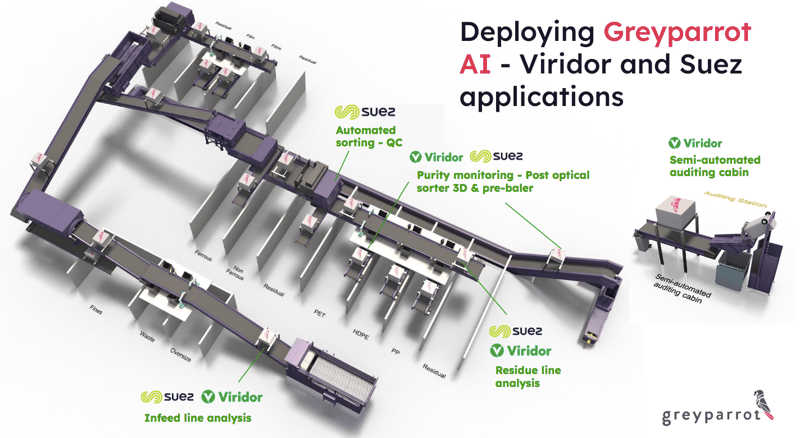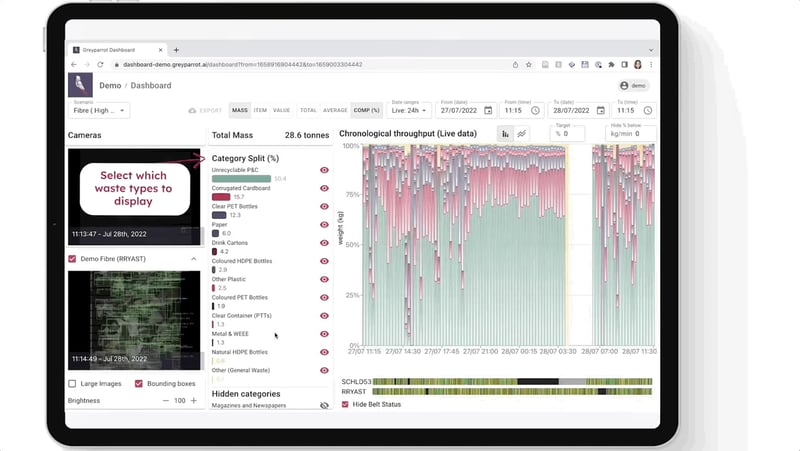The UK and Europe achieve higher recycling rates than the USA.
That’s understandable — the American sector contends with more waste per capita than any other country. There’s already a blueprint for meeting a waste challenge of this scale, though.
US recovery facilities can find a roadmap in the operational shift that’s currently taking place at major European waste recyclers like Viridor and SUEZ. Manual monitoring and waste picking can’t scale to the requirements of modern waste flows, but AI is now accurate enough to to fill persistent waste data gaps in detail. That data can then be used to monitor plant performance, improve sorting efficiency, guide investments, and ultimately, increase recovery rates.
If the American waste sector can digitise, it can achieve the results we’ve seen across the pond. Here’s how two of the UK’s leading waste management organisations have adopted AI, and what they’ve learned in the process:
A waste sector to meet modern challenges
What drives well-established organisations to adopt new technology? While traditional processes may be working, they don’t necessarily meet evolving demands. For Mustafa Azimy, a Production Processing Engineer at SUEZ, long-standing inefficiencies require new solutions:
“There’s not a day I don’t see an opportunity to do something different, or better. The waste sector could be as advanced as something like the automotive industry, but we’re not yet there as a group.”
Technical Managers like Viridor’s Miguel Rosa also face new hurdles to recycling that existing technology can’t fully address:
“Fifteen years ago we adopted near-infrared (NIR) technology, the best tech at the time. Requirements have now changed, particularly when it comes to distinguishing between food and non-food grade material. AI bridges the gap that NIR can’t, and tells us what waste objects were used for. It completely expands what we can do in terms of sorting.”
The results of deployment

At Viridor, innovation has already paid off by revolutionising their understanding of waste composition:
“Everyone in the recycling industry has done a million composition trials. With this system, it’s like we have a 24/7 sampling system. Senior leadership can then make decisions based on data.”
At SUEZ, where our monitors track objects on outfeed lines, AI has answered a crucial commercial question:
“With data gathered throughout the day, it’s possible to make informed commercial decisions. We can better understand what we’re sending to customers, and decide who our most valuable suppliers are.”
New technology won’t undermine existing tools

AI’s ability to fill data gaps doesn’t mean abandoning expensive infrastructure. As Steve notes, the best technologies increase the value of existing investments:
“There’s always a place for robotics, and there are countless optical sorters that do a fantastic job. AI will always be complementary to things like NIR — by integrating computer vision, we can improve the success rate of existing machinery.”
Miguel offered his perspective as a Technical Manager at a PRF:
“There’s isn’t a single machine that’s right for every application. The recognition technology is now here, and with increased computing power there will only be more we can identify.”
The waste data gathered through AI-powered monitoring units isn’t locked in the AI platform. Through open APIs, it can integrate with NIR to provide a fuller picture of polymer and object type, and with robotic sorters to increase the accuracy of mechanical sorting.
In short, it boosts your infrastructure’s IQ.
Why innovators benefit from early adoption
The first wave of adoption is well underway, and innovators are already benefiting from their enthusiasm.
The previously unavailable information that AI provides can surface opportunities for improvement that weren’t even front-of-mind, allowing waste professionals like Mustafa to seek solutions well before competitors. Here’s how he thinks others should dive in:
“Try it for yourself, and find your specific application for AI. For us, it’s been really interesting to track variation in quality and volume throughout the day. It allows you to take a proactive approach to staffing and operations, and plan ahead.”
With the help of AI, innovators can also position themselves as leaders of wider industry change. Miguel sees the technology’s potential to expedite waste sector collaboration:
“Don’t be afraid of the technology. People don’t like change and disruption, but try it, and you’ll see the benefits. We keep data for ourselves at the moment, but there’s big potential for a platform where everyone can report in the same way, with compatible data.”
In short, you’ll learn a lot just by trying new solutions. Technology like AI has the potential to transform entire industries, but it starts with learning how it applies to your individual facility or business. Join that process early, and you’ll have the opportunity to shape its evolution.
.png)
 Mikela Druckman • Dec 16, 2025
Mikela Druckman • Dec 16, 2025.png)




